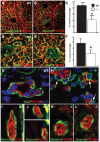CCN2/connective tissue growth factor is essential for pericyte adhesion and endothelial basement membrane formation during angiogenesis
- PMID: 22363445
- PMCID: PMC3282727
- DOI: 10.1371/journal.pone.0030562
CCN2/connective tissue growth factor is essential for pericyte adhesion and endothelial basement membrane formation during angiogenesis
Abstract
CCN2/Connective Tissue Growth Factor (CTGF) is a matricellular protein that regulates cell adhesion, migration, and survival. CCN2 is best known for its ability to promote fibrosis by mediating the ability of transforming growth factor β (TGFβ) to induce excess extracellular matrix production. In addition to its role in pathological processes, CCN2 is required for chondrogenesis. CCN2 is also highly expressed during development in endothelial cells, suggesting a role in angiogenesis. The potential role of CCN2 in angiogenesis is unclear, however, as both pro- and anti-angiogenic effects have been reported. Here, through analysis of Ccn2-deficient mice, we show that CCN2 is required for stable association and retention of pericytes by endothelial cells. PDGF signaling and the establishment of the endothelial basement membrane are required for pericytes recruitment and retention. CCN2 induced PDGF-B expression in endothelial cells, and potentiated PDGF-B-mediated Akt signaling in mural (vascular smooth muscle/pericyte) cells. In addition, CCN2 induced the production of endothelial basement membrane components in vitro, and was required for their expression in vivo. Overall, these results highlight CCN2 as an essential mediator of vascular remodeling by regulating endothelial-pericyte interactions. Although most studies of CCN2 function have focused on effects of CCN2 overexpression on the interstitial extracellular matrix, the results presented here show that CCN2 is required for the normal production of vascular basement membranes.
Conflict of interest statement
Figures





Similar articles
-
Pericytes promote selective vessel regression to regulate vascular patterning.Blood. 2012 Aug 16;120(7):1516-27. doi: 10.1182/blood-2011-01-332338. Epub 2012 Jun 27. Blood. 2012. PMID: 22740442
-
Defining Endothelial Cell-Derived Factors That Promote Pericyte Recruitment and Capillary Network Assembly.Arterioscler Thromb Vasc Biol. 2020 Nov;40(11):2632-2648. doi: 10.1161/ATVBAHA.120.314948. Epub 2020 Aug 20. Arterioscler Thromb Vasc Biol. 2020. PMID: 32814441 Free PMC article.
-
Excess vascular endothelial growth factor-A disrupts pericyte recruitment during blood vessel formation.Angiogenesis. 2019 Feb;22(1):167-183. doi: 10.1007/s10456-018-9648-z. Epub 2018 Sep 20. Angiogenesis. 2019. PMID: 30238211 Free PMC article.
-
Endothelial cell-pericyte interactions stimulate basement membrane matrix assembly: influence on vascular tube remodeling, maturation, and stabilization.Microsc Microanal. 2012 Feb;18(1):68-80. doi: 10.1017/S1431927611012402. Epub 2011 Dec 14. Microsc Microanal. 2012. PMID: 22166617 Free PMC article. Review.
-
The pericyte microenvironment during vascular development.Microcirculation. 2019 Nov;26(8):e12554. doi: 10.1111/micc.12554. Epub 2019 May 27. Microcirculation. 2019. PMID: 31066166 Free PMC article. Review.
Cited by
-
Matricellular proteins of the Cyr61/CTGF/NOV (CCN) family and the nervous system.Front Cell Neurosci. 2015 Jun 24;9:237. doi: 10.3389/fncel.2015.00237. eCollection 2015. Front Cell Neurosci. 2015. PMID: 26157362 Free PMC article. Review.
-
Fibrosis-Associated Signaling Molecules Are Differentially Expressed in Palmar Connective Tissues of Patients with Carpal Tunnel Syndrome and Dupuytren's Disease.Biomedicines. 2022 Dec 11;10(12):3214. doi: 10.3390/biomedicines10123214. Biomedicines. 2022. PMID: 36551969 Free PMC article.
-
Connective Tissue Growth Factor reporter mice label a subpopulation of mesenchymal progenitor cells that reside in the trabecular bone region.Bone. 2015 Feb;71:76-88. doi: 10.1016/j.bone.2014.10.005. Epub 2014 Oct 22. Bone. 2015. PMID: 25464947 Free PMC article.
-
The medicinal activity of lyophilized aqueous seed extract of Lepidium sativum L. in an androgenic alopecia model.Sci Rep. 2023 May 11;13(1):7676. doi: 10.1038/s41598-023-33988-1. Sci Rep. 2023. PMID: 37169776 Free PMC article.
-
CCN2 (Cellular Communication Network factor 2) in the bone marrow microenvironment, normal and malignant hematopoiesis.J Cell Commun Signal. 2021 Mar;15(1):25-56. doi: 10.1007/s12079-020-00602-2. Epub 2021 Jan 11. J Cell Commun Signal. 2021. PMID: 33428075 Free PMC article. Review.
References
-
- Brigstock DR. The CCN family: a new stimulus package. J Endocrinol. 2003;178:169–175. - PubMed
-
- Bork P. The modular architecture of a new family of growth regulators related to connective tissue growth factor. FEBS Lett. 1993;327:125–130. - PubMed
-
- Vorwerk P, Hohmann B, Oh Y, Rosenfeld RG, Shymko RM. Binding properties of insulin-like growth factor binding protein-3 (IGFBP-3), IGFBP-3 N- and C-terminal fragments, and structurally related proteins mac25 and connective tissue growth factor measured using a biosensor. Endocrinology. 2002;143:1677–1685. - PubMed
-
- Hashimoto G, Inoki I, Fujii Y, Aoki T, Ikeda E, et al. Matrix metalloproteinases cleave connective tissue growth factor and reactivate angiogenic activity of vascular endothelial growth factor 165. J Biol Chem. 2002;277:36288–36295. - PubMed
Publication types
MeSH terms
Substances
Grants and funding
LinkOut - more resources
Full Text Sources
Other Literature Sources
Molecular Biology Databases
Miscellaneous

